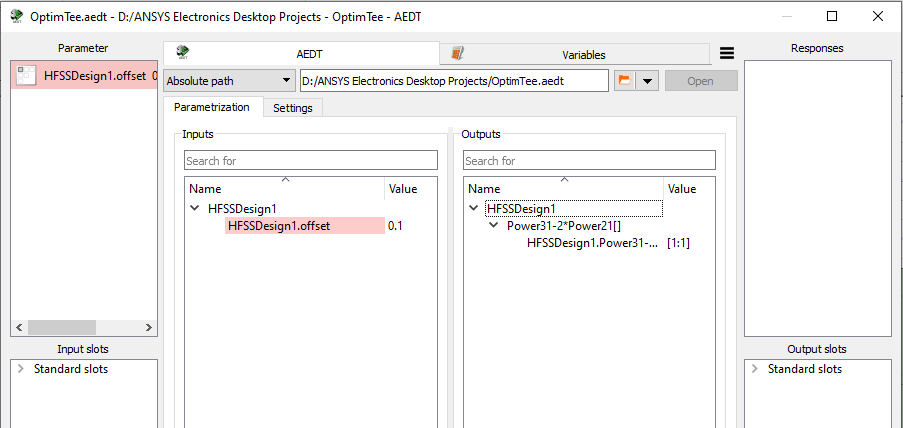Parametrization for optiSLang Integration
Certain AEDT data must exist before optiSLang can use it.
Variables act as Inputs in optiSLang, while simulation results (reports) act as Outputs.

Inputs
When integrated with AEDT, optiSLang automatically detects project variables and design variables for every design in the project. Note that:
- Dependent parameters are skipped.
- Any parameter marked as "hidden" is always included.
Users decide whether to treat parameters from different models in the project as independent or communal (kept synchronized). In optiSLang, the AEDT integration has a Shared Parameters View with an additional Include non-omnipresent parameters as shared option.

In AEDT, project variables can be used to steer model parameters.
It is best to leverage features on both sides of the optiSLang-AEDT integration for managing overlapping (that is, partially synced) parameter sets. optiSLang's standard parametrization management tools offer the parameter type Dependent for aligning or otherwise controlling parameters.
In the context of bundling optiSLang-demanded designs for simultaneous execution as DSO jobs, remember that DSO design variation tables are hosted in the Optimetrics section of each design, and that there is no Optimetrics branch at the project level. So, even varying only project variables will still yield separate DSO tables and thus separate jobs for each model in the project.
A project walker mechanism inquires a given AEDT project and stores the generated project structure info in a JSON file for optiSLang. If the same reference project is linked for use in a different AEDT node even from a different optiSLang project, the stored project inquiry results can be recalled and the parametrization can be instantly displayed. This mechanism spares users wait time for the project inquiry call.
Outputs
The framework for result data transfer from AEDT to optiSLang is very simple: each report trace shows up in optiSLang response listings as a signal object. You can register the signals directly or apply math functions offered by optiSLang's calculator with each integration node. The transfer vessels are CSV files.
Even such plots as Smith charts or 3D polar plots can be collected as groups of signal objects using the uniform CSV file export function offered in AEDT.
Parameterization with optiSLang Analysis Goals in Mind
The parametrization scheme should connect to the goals of the optiSLang analysis.
Bad parametrization might hide the design optimum from the best optimizer or destroy the connection of a robustness sampling with reality. Thoughtfully improved parametrization can achieve simulation goals with a fraction of the designs that would be needed for a task within the most simple ad hoc parametrization scheme.
The algorithms being applied in a specific scenario should also guide your parametrization scheme. For example, it makes sense to give a robustness sampling algorithm the chance to examine a parameter space where the simulation can represent the relevant physical effects happening in the real world. An optimizer algorithm, meanwhile, needs the chance to hit feasible designs frequently.
Some tips:
- Think ahead to devise a stable and meaningful parametrization
- Be attentive to the kinds of errors encountered by failing designs
- Be quick to eliminate the origins of errors that appear most frequently in error logs
- Learn to use optiSLang post-processing as a diagnostic toolbox
- Apply feedback and lessons learned to your parametrization schemes
